There was general consensus amongst the Allies commanders that the invasion into France would not be possible until at least 1944. There was considerable debate as to what was the best possible course of action to weaken the German hold on Europe.
The Italian or Mediterranean campaign began with the Allied invasion of Sicily began 10 July 1943 at the Gulf of Gela. Both amphibious and airborne forces were involved. The US contributed the 7th Army (Lt-Gen Patton) and the British contributed the 8th Army (Gen Montgomery). The 8th Army included the 1st Canadian Infantry Division and the 1st Canadian Tank Brigade. On 17 August 1943, the Germans were able to evacuate most of their forces to mainland Italy.
On 3 September 1943 (Operation Baytown), the 8th Army landed in Italy. On the same day, the Italian government agreed to an armistice with the Allies. Five days later, the armistice was announced to the Italian public by radio. The German forces would continue to defend Italy on their own.
Two more amphibious landings took place on 9 September 1943: Operation Avalanche (US 5th Army, Salerno) and Operation Slapstick (British 1st Airborne Division, Taranto). As the allied forces moved north, they encountered the Apennine Mountains. These mountains cover half the width of Italy around Abruzzo. Some of the peaks reach almost 1000 m and the rough terrain and the flood prone rivers make it easy to defend.
In early October 1943, Army Group Commander in Southern Italy, Field Marshal Albert Kesselring ordered the preparation of a series of defensive lines south of Rome. Two of these lines (Volturno, Barbara) were used for delay actions while the Winter line (Gustav, Bernhardt, Hitler/Senger) was finished. The Winter line practically halted the 5th Army advance along the west coast by the end of 1943. The harsh winter conditions stalled the 8th Army in the east near Ortona.
It took four major offensives between January and May 1944 before the line was eventually broken by a combined assault of the Fifth and Eighth Armies (including British, American, French, Polish, and Canadian corps). The American forces took possession of Rome on 4 June 1944
After the Allied invasion of Normandy, the U.S. VI Corps and the French Expeditionary Corps (CEF) were moved to the European theatre for the invasion of Southern France. They were replaced by the Brazilian 1st Infantry Division, the U.S. 92nd Infantry Division ( both in the second half of 1944), and the U.S. 10th Mountain Division (January 1945).
In summer 1944, the Allies advanced beyond Rome, taking Florence and closing up on the Gothic Line. The Gothic Line was attacked and penetrated during Operation Olive (25 August 1944) without a decisive victory. In early 1945, the British 5th Infantry Division and I Canadian Corps moved to northwestern Europe.
By March 1945, U.S. IV Corps (1st Brazilian Division and the newly arrived U.S. 10th Mountain Division) were able to finally push the German defenders from the commanding high point of Monte Castello and the adjacent Monte Belvedere and Castelnuovo, depriving them of artillery positions that had been commanding the approaches to Bologna. The Allies’ final offensive commenced with massive aerial and artillery bombardments on 9 April 1945.
By 25 April 1945, the rapid advance towards Turin by the Brazilian division took the German–Italian Army of Liguria by surprise, causing its collapse.
General Heinrich von Vietinghoff officially surrendered on 29 April 1945.
Authors note: Although the official nomenclature for the period is the 11th Army Tank Regiment (The Ontario Regiment (Tank)), 12th Army Tank Regiment (Three Rivers Regiment (Tank)), and 14th Army Tank Regiment (The Calgary Regiment (Tank)) – this page will refer to the units as current Ontario Regiment (OntR), Three Rivers Regiment (TRR), and the Calgary Regiment (CalR)
There was general consensus amongst the Allies commanders that the invasion into France would not be possible until at least 1944. There was considerable debate as to what was the best possible course of action to weaken the German hold on Europe.
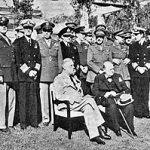
The Casablanca Conference was held at the Anfa Hotel in Casablanca, French Morocco, from January 14 to 24, 1943. It planned the Allied strategy for the next phase of World War II. Although President Roosevelt and Prime Minister Churchill attended, Joseph Stalin did not. The key points committed to were "Unconditional Surrender" of the Axis powers and attacking Sicily/Italy before invading Europe.
The British Government (under pressure from the Canadian Government ) requests from the Canadian General McNaughton -, a Canadian contingent for Mediterranean operations. It is approved within 48 hrs. 1 Canadian Infantry Division and 1st Canadian Tank Brigade are tasked to Operation Husky. This decision was not well received by Gen McNaughton and was one of the reasons he retired seven months later.

Within days of the request, 1CTB had moved from Sussex to Scotland for training. Upon arrival, they were issued with M4A4 Shermans - the first Shermans issued to Canadian Tankers.
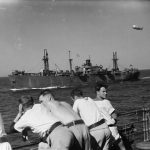
To support Operation Husky, 26,000 soldiers with all of there supplies and vehicles had to be transported to Sicily from the UK. This was done with two convoys: a "fast" convoy of troop ships and a "slow" convoy of supply ships. These initial convoys were followed up with two more supply convoys. The two assault convoys met off of the coast of Algiers on 5 May 1943 and proceeded to Sicily together.
The "Fast" assault convoy was never attacked but the slow convoy was attacked by submarines and had three ships sunk with a loss of over 500 vehicles and artillery pieces - worse was the loss of life - 55 Canadians lost their lives.
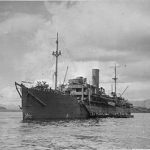
On 9 July 1943, both various assault convoys rendezvoused southwest of Malta; and proceeded to Sicily.
The enemy seemed to be unaware.
(image - HMS Hilary HQ ship of the attack) During the day, the weather was hot and cloudless. But later in the day, a gale appeared. This gale led the naval adviser of the Italian Costal Defence to assure his chief that landings were impossible that night.
That evening, the wind fell and it appeared that landing would be practicable.
The German operations log showed that indicates that at 4:30 p.m. on 9 July German reconnaissance aircraft spotted convoys steering towards Sicily. By 6:40 p.m. “all troops in Sicily had been alerted”
The assault began with an airborne assault at midnight 10 July 1943. Two bridges were attacked by a mix of British Glider and Parachute troops and the American Paratroopers dropped to secure the area behind the American beachhead.
Beach landings were made on 26 main beaches spread along 105 miles (169 km) of the southern and eastern coasts of Sicily.
The Americans (3rd Infantry Division) landed on the Southern Coast and the combined British and Canadian units landed on the east coast.
The Italian defense was practically non-existent and there was no serious opposition so the Allied forces quickly moved inland.
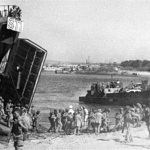
At 0900, the 12th Army Tank Regiment (Three Rivers Regiment) landed as part of the Divisional Reserve. By 1030, the first Squadron was operational and by 1530, the entire regiment was in good order.
The other two regiments of the 1CATB were still aboard their transport ships as part of the slow assault convoy.
The OntR and CalR were expected to land in Syracuse on 11 July 1943 but did not land until 13 July 1943.
After three days of advance, the Hastings and Prince Edward Regiment (HastyP's) and A Squadron TRR, advanced on the town of Grammichele. Grammichele sits on a ridge more than 100m above the countryside.
The TRR reconnaissance section, accompanied by a platoon of Hasty P's B Company mounted on tanks, precedes the main party when the lead tank was hit by a German 88. Cpl Ernie Madden in his Universal Carrier was 50 m away from the tank and charged the 88 while it was reloading, killing its crew.
The town was held by elements of two battalions of the Hermann Göring Panzer Division including artillery and tanks. Three companies of the Hasty P's stormed the town supported by A Squadron and the Germans withdrew before noon with the TRR and the 48th Highlanders in pursuit.
The hasty attack captured seven artillery pieces, six trucks, and four Panzer Mark IVs. Canadian causalities were on the order of one killed and eight wounded.
At noon on the 16th, C Squadron of the TRR was leading 2nd Brigade towards Piazza Armenia. About 5km south of the town, the road bent sharply and entered a gully. When the lead tank entered, it was ambushed and destroyed.
The Loyal Edmonton Regiment deployed company sized attacks and gained the high ground but the Germans still occupied the town. The town was captured the next day as the Germans had retreated.
That afternoon, B Squadron TRR lead the advance for six km until a blown bridge brought the advance to a halt. After the engineers repaired the bridge, it was determined that the Germans were in strength in the area of the Grottacalda Pass and that a two-brigade deliberate attack would be required to clear the way to the towns of Enna and Valguarera.

US and UK European Strategy
The US and England had very different attitudes on how best to start the next phase of the war.
With the defeat of the German/Italian forces, valuable and experienced troops were available.
With their large military, US commanders wanted an immediate attack on France. This view was echoed by the Soviet Union who had been calling for a "Second Front".
The British pressed for an attack on Sicily and then moving on to Italy. It was thought that this would quickly remove Italy from the war and siphon German forces out of Europe.

!st Canadian Tank Brigade in Scotland

As soon as possible, the regiments of the 1CTB were sent to Scotland for advanced training.
The training started with a six week introduction to the M4A4 Sherman tank.
The Three Rivers Regiment was tasked to directly support the amphibious landing so it also spent much time learning to embark and disembark from LSTs.
The firing range at Kirkcudbright was used to practice with both Armour Piercing and the new High Explosive rounds.
Final weeks were spent waterproofing and painting the tanks.
By the end of June 1943, all of the vehicles were loaded onto LSTs and ready to move.

M4A2 Sherman Medium Tank
The M4A4 was also known as the British Sherman Mk.V.
They were manufactured from July 1942 to November 1943, in all almost 7500 being built.
It had same gun as earlier makes (except for those upgunned to Sherman Fireflys) and a welded hull that provided more protection even with less armour.
The biggest change was the used of the Chrysler multibank engine which was made of five car engines around a central drive shaft. This needed more space so the hull was lengthened by 15 cm/5.9 in). It also required more maintenance.
Most went to the UK and were issued both to UK forces as well as members of the commonwealth.

Slow Assault Convoy 19 June 1943
The bulk of the transport and stores required to support the first attack, together witha small number of troops, was carried in the "Slow Assault Convoy". This convoy sailedfrom the United Kingdom in two groups; the first, consisting of eight L.S.Ts., setting outon D minus 21 (19 June), the other, made up chiefly of seventeen cargo vessels, leaving five days later. These two sub-convoys joined at Algiers on D minus 5, and to proceed to Sicily at 8 knots.
On the night of 4-5 July Axis submarines lurking off the North African coast
between Oran and Algiers torpedoed two of its merchantmen, the St. Essylt and the City of Venice. The former vessel. was abandoned in flames; and an attempt to tow the sinking City of Venice to Algiers failed. On the following afternoon a third ship, the Devis,carrying the Commodore of the convoy, was also hit. She caught fire and sank in twenty minutes.
Of the more than 900 troops aboard these three ships, 593 were Canadians. In the first two sinkings, there was minimal loss of life; among. the Canadians one officer and five enlisted. Casualties were heavier aboard the Devis, which carried 261 Canadian and 35 British officers and men. 52 Canadian other ranks were reported as missing and presumed dead.
The loss of the cargo carried by the three vessels was serious. More than 500 vehicles and forty artillery pieces were lost.

Fast Assault Convoy 28 June 1943
The majority of the troops, including the 1st Canadian Infantry Division sailed on the were assigned to the "Fast Assault Convoy" which left the UK on D minus 12 (28
June 1943)
The convoy comprised of a dozen vessels:

Follow up Convoys
The two follow-up convoys carried the Tank Brigade-less the 12th Army Tank
Regiment (Three Rivers Regiment), which was to take part in the assault-the Canadian
hospital installations and No. 1 Base Reinforcement Depot, and various other units not
required for the assault itself. A slow convoy of 42 ships sailed from Scotland on 25 June,
and was followed on 1 July by the ten ships of the faster group.

Air Support for Operation Husky
Through the Mediterranean, the Allied convoys had kept close to the southern shore so they could have adequate air cover. From 1- 9 July 1943, the Northwest African Coastal Air Force flew a total of 1426 sorties while the Air Defences Eastern Mediterranean Command flew 1421 sorties. Naval aircraft flew an additional 600 sorties on antisubmarine patrols and submarine hunts.
On the morning of 9 July and the ships passed Malta, fighters took off from the Malta's airfields to cover them with a defensive perimeter of 60 miles' radius.
Key to the effective use of air power, was the massive bombing effort against enemy airfields, ports, and submarine bases. For six weeks prior to the landing, bombers and fighter-bombers of both air commands flew 2292 sorties against airfields in Sicily, Sardinia and Southern Italy, and 2638 against other strategic targets in
these areas. This escalated in the week before the landing. Airfields in Sicily were targetted, especially the fighter aircraft.
Between 4 and 9 July, 373 heavy and 560 medium bomber sorties flown by the Northwest African Air Forces and by Ninth United States Air Force Liberators based out of Cyrenaica. German losses were heavy.
Major-General James H. Doolittle's Northwest African Strategic Air Force No. 331 (R.C.A.F.) Wing contributed 3 RCAF Willington night bomber squadrons (No. 420 (City of London), No. 424 (City of Hamilton) and No. 425 (Alouette) )
All of this action rendered most Sicilian air fields unusable and the fighter cover having to move to bases in Italy.

German and Italian Defenses in Sicily
The Axis air forces had been seriously wekened by the Allied bombing campaign. By the landing day, the German 2nd Air Fleet reduced to some 430 aircraft (250 fighters) and the Italian Regio Aeronautica, had all of their 325 aircraft moved to the mainland only 200 of those were fighters.
Concentrations of flak artillery were emplaced along the east coast and at the western tip of Sicily to defend the Strait of Messina and the important cities
Italian naval forces seemed to be considerable; being six battleships and seven cruisers, besides a large number of destroyers, torpedo boats and submarines. These had been dispersed to protect them from air attack. As they had not sortied in three years, morale and experience was lacking. German naval assets were two small flotillas of E-boats based respectively at Cagliari in Sardinia and Porto Empedocle on the south coast of Sicily. The Germans did not have the Naval strength to stop the invasion and they doubted that the Italians had the ability.
Allied intelligence placed the number of Axis ground troops on the
island at 323,500 with over eighty per cent of these were believed to be Italian troops. In reality, there were probably no more than 40,000 German and 230,000 Italian troops in Sicily on 10 July 1943.
There were two types of forces; static costal defense and mobile field units held in the center of Sicily.
Italian assets comprised of the Sixth Army. The Sixth Army consisted of two corps, the 12th and the 16th, comprising a total of four field and the equivalent of six coastal divisions. There was one armoured company equipped with French Renault ("R.35") or Italian "Fiat 3000" tanks.
The Italian coastal divisions were second line troops without strong defenses along the assault beaches. This averaged to 26 men, two automatic rifles and three machine-guns per kilometer, with two pieces of artillery every three kilometers.
Neither the Italian nor the German High Command was ignorant of the
ineffectiveness of the Italian garrison in Sicily.
German troops were the 15th Panzer Grenadier Division (104th, 115th and 129th Panzer Grenadier Regiments) , the 90th Panzer Grenadier Division and the Hermann Göring Panzer Division. The bulk of the Hermann Göring Panzer Division had been destroyed in Tunisia, but it was reorganized from reserves.

Operation Ladbroke and Operation Fustian
Operation Ladbroke
Operation Ladbroke's objective was to capture and hold Ponte Grande Bridge near the city of Syracuse; followed by capturing Syracuse and its port facilities. This was to be accomplished by the British 1st Airlanding Brigade using gliders launched from Tunisia.
The Operation required 136 Waco Hadrians and eight Airspeed Horsas. Sixty-five gliders released too early by the towing aircraft and crashed into the sea, drowning approximately 252 men.
Only eighty-seven men arrived at the Pont Grande Bridge. They captured the bridge and held it. The relief forces failed to arrive on time but the British forces still held. They only surrendered when they ran out of ammunition and were down to 15 men.
The Italians attempted to destroy the bridge but were unsuccessful.
Operation Fustian
Operation Fustian was an airborne forces operation undertaken to capture the Primosole Bridge across the Simeto River. It was carried out by the British 1st Parachute Brigade three days after the inital landing. The operation intent was to land the Parachute Brigade around the bridge and support them with glider-borne troops until relieved by British XIII Corps.
Many of the air transport was shot down or damaged and turned back. The brigade was scattered with only a couple of companies worth of paratroopers landing on or near the bridge. Regardless, the British Troops were able to capture the bridge but were only able to hold out until nightfall.
The next day, the remainder met up with the 9th Battalion, Durham Light Infantry and some tank support, attempted to recapture the bridge - it took three days to capture the bridge.
American Airborne Operations
The 504th and 505th Parachute Regimental Combat Teams of the 82nd Airborne Division was the American airborne contribution to the Allied invasion of Sicily
The American attack was a pure parachute assault. The number of transport aircraft available limited the amount of men to about 3,400 in total.
On the evening of 9 July 1943, the aircraft left Tunisia. They flew at low levels behind the British. As they neared their drop zones, the winds became heavy which resulted in the parachutists being widely scattered and many landing injuries.
The paratroopers commenced operations to cause as much confusion to the enemy as possible; capturing or destroying defensive works and vital road crossings. The next day, the Hermann Goering Division started to move south to attack the beaches held by the American Infantry. About 250 parachutists held the Biazza Ridge and were able to turn the attack with the help of Naval gunnery.

Initial Landing
The Canadian landing was to be made on a two-brigade front, and the Special Service Brigade.
In the first phase of the operation the 1CIB (The Royal Canadian Regiment, The Hastings and Prince Edward Regiment, and 48th Highlanders of Canada) would land to the east of le Grotticelle, and would destroy the enemy coastal battery reported near Maucini, capture the Pachino airfield, and establish contact with the other formations of the 30th Corps in the neighbourhood of Pachino town.
West of le Grotticelle, the 2CIB (Princess Patricia's Canadian Light Infantry, The Seaforth Highlanders of Canada, and The Loyal Edmonton Regiment) was to advance west and destroy beach defences, meet and assist the Special Service Brigade in its operation, and subsequently take up positions north of the Pantano Longarini marsh and patrol towards the north-west.
The Special Service Brigade would land immediately to the west of Punta Castellazzo, and hence on the extreme left of the Eighth Army's front, and having overcome enemy resistance in the area, reorganize on the high ground to the north-west of the salt marshes.
The landings of the two infantry brigades were to be made at H Hour, which was set at 2:45 a.m.; the Commandos were to touch down ten minutes earlier.
Italian defenders from the 206th Coastal Division had an array of pillboxes, machine guns and two batteries of 6-inch guns. The Canadian official history described the defences all along the coast as "not very formidable." In the BARK WEST sector, there were fifteen pillboxes and about 20 machine gun posts, "some barbed wire" on the beach, and suspected anti-tank mines. Other defended positions lay inland, particularly towards the airfield. The two coastal batteries lay 1-1/2 miles north-east of ROGER, and two miles east, the latter in the sector of the 51st Division. A third battery (found to include four 6-inch howitzers) was sited on Pachino's northern outskirts, able to cover the approach to the airfield. Manned by determined troops, all of these defences would have been troublesome; as it was, the Canadians counted on enemy inexperience as well as aerial superiority and naval gunfire to help win the day.
During the second phase of the operation the divisional reserve (3CIB (Royal 22e Regiment, The Carleton and York Regiment, and The West Nova Scotia Regiment) and TRR) and artillery and medical units, would proceed ashore, while the assaulting brigades captured high ground astride the PachinoIspica road and the whole Division reorganized for the third phase-an advance to the north-west in conformity with the Highland Division.

Cpl Bob Gladnick Anecdote
Bob Gladnick was an American who had fought in the Spanish Civil War and joined the Three Rivers Regiment (TRR).
He was a corporal in the TRR Reconnaissance and was sent on patrol early on 10 July 1943 in Sicily while the Regiment was consolidating.
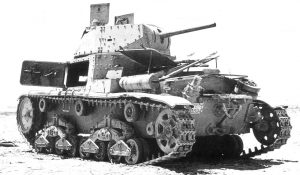 Mounted on a Universal Carrier about four kilometers inland, they came across an Italian force of approximately 1000 men and 50 FIAT Ansaldo tanks (see image).
Mounted on a Universal Carrier about four kilometers inland, they came across an Italian force of approximately 1000 men and 50 FIAT Ansaldo tanks (see image).
Highly out gunned, he drove into the centre of the opposing force and yelled in semi-Italian "Donde este el commandante?" (Where is your commander?).
An Italian Brigadier arrived and was told by Gladnick that he was expected to surrender at once. The Brigadier agreed under the condition that he surrender to a Canadian Officer of equal rank.
Wearing only boots, shorts, and a helmet; Gladnick announced himself the to Italian Brigadier as "Gererale Maggiore" (Major General). The Brigadier saluted and proclaimed that he was proud to be surrendering to a higher authority. Gladnick then ordered him to move his tanks and trucks off the road, surrender to the soldiers following on, and continued on his mission.
For this, he was promoted to Sargent.

DUKW Amphibious Truck
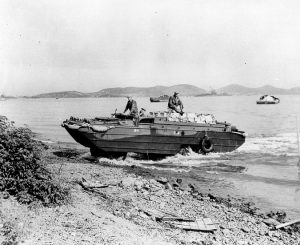 The DUKW was built around the GMC CCKW six-wheel-drive military truck by building a boat around the chassis.
The DUKW was built around the GMC CCKW six-wheel-drive military truck by building a boat around the chassis.
It could drive on its 6X6 wheels at 80 kmh or use a propeller which could push it through water at 5.5 knots. It could carry 2,300 kg of cargo or 24 persons. It was not an armored vehicle but did have a sheet steel hull.
2,000 were supplied to the UK through Lend Lease and 100 were used by the Canadians in Operation Husky to transfer cargo from the ships across the sand bars and to the beaches. Canadians also used them in the battle of the Schedlt.

8.8 Cm Flugabwehrkanone (FLAK)
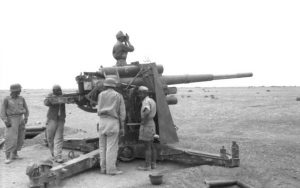 The 8.8 cm Flak is a German 88 mm anti-aircraft and anti-tank artillery gun, developed in the 1930s. Flak is a contraction of German FLugAbwehrKanone meaning "aircraft-defense cannon". The guns werecalled as the Acht-acht ("eight-eight") by Germans and the "eighty-eight" by the Allies.
The 8.8 cm Flak is a German 88 mm anti-aircraft and anti-tank artillery gun, developed in the 1930s. Flak is a contraction of German FLugAbwehrKanone meaning "aircraft-defense cannon". The guns werecalled as the Acht-acht ("eight-eight") by Germans and the "eighty-eight" by the Allies.
The 8.8 cm FlaK to be fired in a limited anti-tank mode when still on its wheels and it could be completely emplaced in only two and a half minutes.
The gun had an effective anti-tank range of 14,000 m and its crew of 11 could fire between 14 and 20 rounds a minute. Its weight of 7,407 kg (16,330 lb) meant that it needed heavy towing vehicles to move it, limiting it use.
The 88 had a fiercesome reputation in WW2. When introduced, it could defeat any tank armour at the time. Until the Centurion was introduced, it could still command the battlefield.

8.8 Cm Flugabwehrkanone (FLAK)
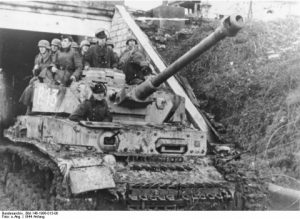 The Panzerkampfwagen IV or the Panzer IV, was a German medium tank built from 1936-45 with a total of over 8,500 built. Its base weight was 22 tonnes and the first six variants used a short barreled 75mm gun and the last for variants used a long barreled 75mm gun.
The Panzerkampfwagen IV or the Panzer IV, was a German medium tank built from 1936-45 with a total of over 8,500 built. Its base weight was 22 tonnes and the first six variants used a short barreled 75mm gun and the last for variants used a long barreled 75mm gun.
The operational theory was that the Panzer III and IV would field together as a team. The Panzer IV would support the infantry and the III would assume the anti-tank role. Since the Panzer IV had a large turret ring, it could hold a larger gun so the roles were reversed mid-way through the war.
The Panzer IV saw service in all combat theaters involving Germany and was the only German tank to remain in continuous production throughout the war. The Panzer IV was replaced by the Panther Tank.

8.8 Cm Flugabwehrkanone (FLAK)
The 8.8 cm Flak is a German 88 mm anti-aircraft and anti-tank artillery gun, developed in the 1930s. Flak is a contraction of German FLugAbwehrKanone meaning "aircraft-defense cannon". The guns werecalled as the Acht-acht ("eight-eight") by Germans and the "eighty-eight" by the Allies.
The 8.8 cm FlaK to be fired in a limited anti-tank mode when still on its wheels and it could be completely emplaced in only two and a half minutes.
The gun had an effective anti-tank range of 14,000 m and its crew of 11 could fire between 14 and 20 rounds a minute. Its weight of 7,407 kg (16,330 lb) meant that it needed heavy towing vehicles to move it, limiting it use.
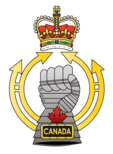
By using this site, you agree to our terms and conditions.
Terms and Conditions.
Copyright
Contact us by email.
© 2020 Royal Canadian Armoured Corps Association
